JOURNAL OF REGENERATIVE BIOLOGY AND MEDICINE
Control of Mind using Nanotechnology
| ReceivedApr 28, 2020 | RevisedApr 30, 2020 | AcceptedMay 16, 2020 | PublishedMay 16, 2020 |
Prithiv K R Kumar1* and Albert Alukal2
1Director, Principle Scientist- Poichyadical Stem Cell Centre for Research and Development (POSCERD) Chicago, CEO- Lazer Health Care, Chicago, USA
2Junior Scientist- Poichyadical Stem Cell Centre for Research and Development(POSCERD), Medical Officer- Lazer Healthcare, Chicago, USA
*Corresponding Author: Prithiv K R Kumar, Director, Principle Scientist-Poichyadical Stem Cell Centre for Research and Development (POSCERD) Chicago, CEO- La’zer Health Care, Chicago, USA
Received Date:04-28-2020; Published Date:05-16-2020
Copyright© 2020 by Kumar PKR. All rights reserved. This is an open-access article distributed under the terms of the Creative Commons Attribution License, which permits unrestricted use, distribution, and reproduction in any medium, provided the original author and source are credited.
Abstract
Mind argumentation is an important parameter which is difficult to analyses. With the basics of technique, it will be a highly impossible task. Hence a technology as powerful as Nano is desired to attain limitless combination or function and properties of nervous cells. Nano particles have different materials, size and shapes. Size ranging from 1-100nm, shape of tubes, spheres, single, double or multiple layers, fullerenes with or without branches and materials such as carbon, metal, ceramic, semiconductors, polymers and lipids. How does that control the mind? Nanotechnology is a game changer in pharmaceutical industry, drug delivery system, Nano sized capsules and medical tools. Having this massive knowledge, nanotechnology can be used in neural tissue growth, also adapts devices for interference of neural networks. The application to neural cells leads to image mapping and delivery therapy. Image mapping is focused on central nervous system, also paving way for innovative image mapping technology. Nano particles play a common role in anatomic and physiologic compartments, i.e.) blood-brain barrier ([BBB]). There are challenges in design of Nano particle relating to brain. Especially Nano medicine where technique is involved and the role function in which these Nano particles apply to central nervous system (CNS) and imaging of CNS. BBB is more complex structure in the entire body, they protect the CNS and they help in movement of ions and even smaller macromolecules from blood to brain. This review will focus on the imaging of CNS and augmentation of brain. It speaks volume about control of mind through imaging and blood barrier supporting CNS.
Keywords
Nano-medicine; Stem cells; Nanotechnology; Brain.
Introduction
Understanding the module of brain activity, neuroscience has a long-standing leverage on brain activity. They deliver biocompatible ultrasound induced imaging for development of uncaged drug [1]. The image of mind control part of the brain [1].
Figure 1: The image of mind control part of the brain.
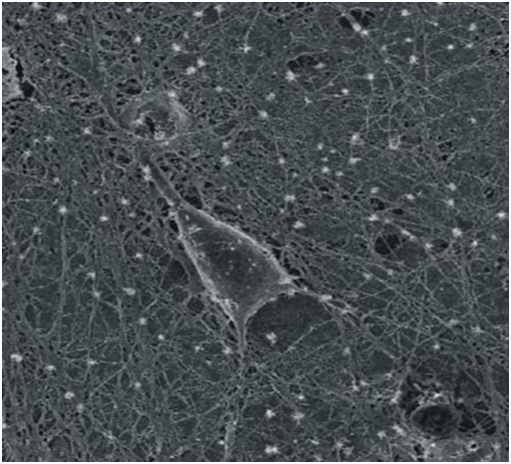
However, there are secondary effects in the brain that maps the changes in functional network where drugs are targeted to particular part in brain. This is the neuromodulation of the brain. It is invasive and compelling part, allowing control of varies modes in communication[3]. Below figure shows the nanomaterials inducing nervous growth[2].
Figure 2: The Nanomaterials inducing nervous growth.
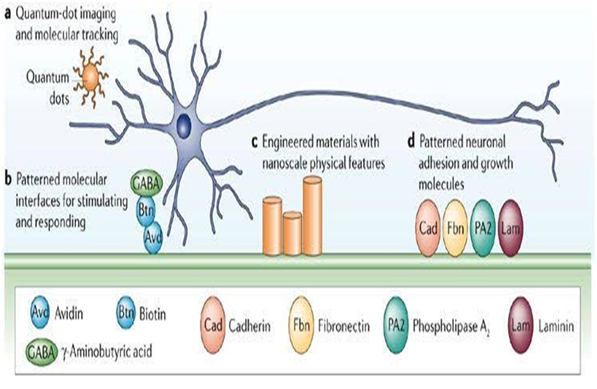
We further demonstrate curing of neuroscientific injuries using drug, that derives secondary changes in the brain, these changes are directly linked with local stimulus of targeted regions in the central nervous system[3]. Thus, brain augmentation is an uphill task, with several counterports adapted in order to create a grey area. Further vision of nano implants in the brain could alter the way brain works. It has its own biochemical benefits which help in providing proper nutrition and food for the brain[20]. There can be mental implications to the organic and neural complexity to the brain.Thus, innovative technology is further discussed to controlling of mind[4].Below figure indicates mind can be controlled through innovative technology[6].
Figure 3: Indicates mind can be controlled through innovative technology.
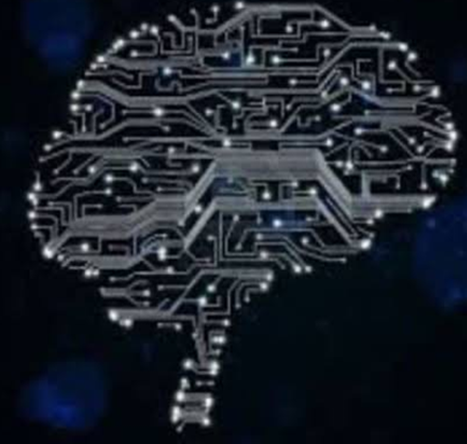
Educating Brain Augmentation
It is important to argue about knowledge in organic and complexity of thinking. Thethrive to achieving the desired knowledge in cognitive level of individuals is a primordial factor in brain cells[24]. This level in brain supersedes the previous instincts, thus suggesting the improvements in developing nanomaterials for brain augmentation. These practises are often given hope to clear understanding of an individual mind[5].Below figure indicates the neuronano technology for brain augmentation[7].
Figure 4: Indicates the neuronano technology for brain augmentation.
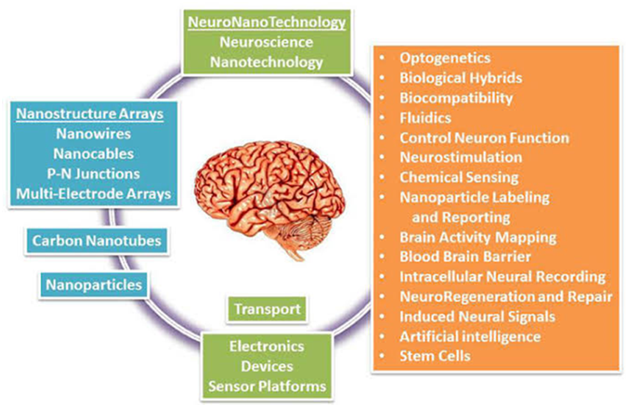
Different generations from primitive era, helped us in understanding the pinnacle of brain and its functions[8]. Leaning from peers led to the elaborate understanding of intelligence in each individual. Thus neuroscience has gradually evolved from understanding intelligence level to mapping and recording patterns minute after minute[7-9]. Even the thinking has evolved through brain wave techniques associated with individual behavior. The goal is to achieve the visualization of mind and its thoughts while recording brain waves[8]. During the experiment, many structural and behavioral changes occur in brain topography. The physical changes occurring in the brain could count for the invasive and pharmacological techniques in improving our memory and intelligence[9]. Below figure shows the map of brain augmentation, memory decoder[10].
Figure 5: The map of brain augmentation, memory decoder.
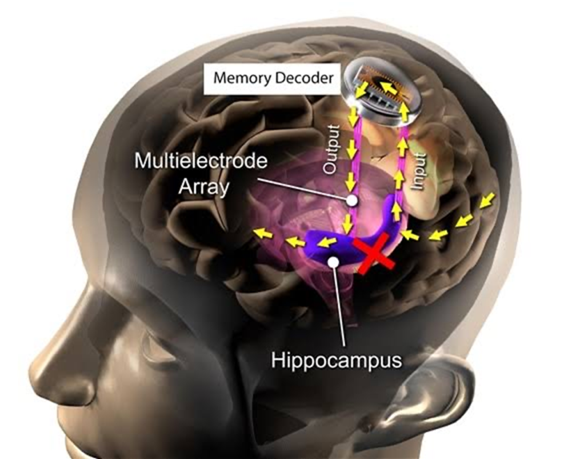
Behavior of Brain cells
Cells in the brain do not differentiate between taught and self-learned. They are trained to perform repeated tasks, with some analyses[11]. Some tasks have been asked to perform under constant monitoring of cerebral structure throughout the trial. Constant behavioral changes have been noticed in prefrontal cortex region, thus increasing the grey matter[13] Changes also observed in right hippocampal region and cerebellum, thus giving an indication to transition of understanding mind. The significant increase in grey matter also indicates that the can be working towards increasing mental capabilities, motor skills, navigation skills and also improving thinking coupled with skills for knowledge and playing games[12].Below shows nanoparticle inside brain to activate control of mind[14].
Figure 6: Nanoparticle inside brain to activate control of mind.
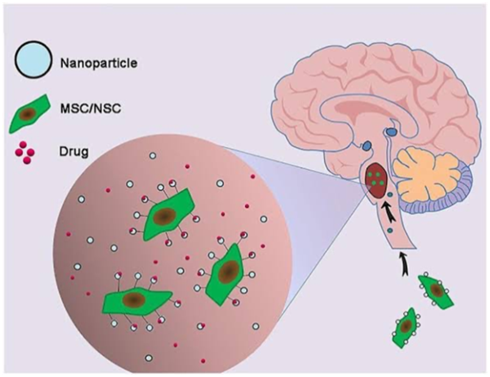
Nanoparticles alter the way the drugs attribute to their delivery[16]. They target the specific areas of the body, help in permeability factors in order to program the release of the drug. The mechanism is usually controlled by reactions of chemical engines linked to magnetic particles to put through external signals[15]. They also significantly reduce side effects of the drugs injected via BBB barrier[17].Below is the figure for BBB pathway[19].
Figure 7: BBB pathway.
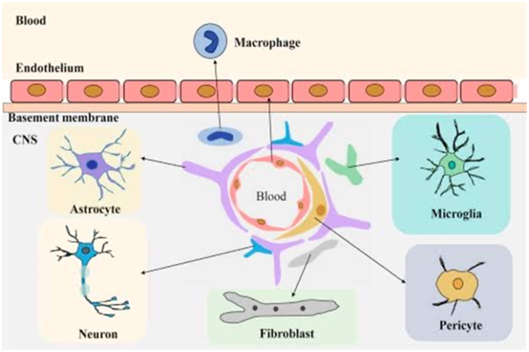
Nanoparticle and blood brain barrier transportation
Psychological disorders, electric stimuli and drug pathways are also invasiveness for drug discovery[18]. Normal drug can’t enter the blood brain barrier; hence nanocapsule plays a vital role in drug penetration through the barrier[20]. Recent studies have shown that nanocapsules are capable of penetrating the blood brain barrier with certain technology, namely ultrasonic waves[49]. Another study has shown that nanocapsules injected through plasma protein surfactants targets these polymeric nanoparticles to specific sites of barrier allowing it to release these drugs to brain[23] these technologies are hence named nanoencapsulation [21]. They are vastly used in rat models to test for the drug uptake and side effects owing to the drug uptake. These are also clinically tested to influence the central nervous system for drug reaching specific targets. Thus brain augmentation will be successful once drug penetrates blood brain barrier and reach the specific target[21-26]. Below shows the figure, nanocapsules testing on rat’s blood brain barrier penetration is seen[24].
Figure 8: Nanocapsules testing on rats- blood brain barrier penetration is seen.
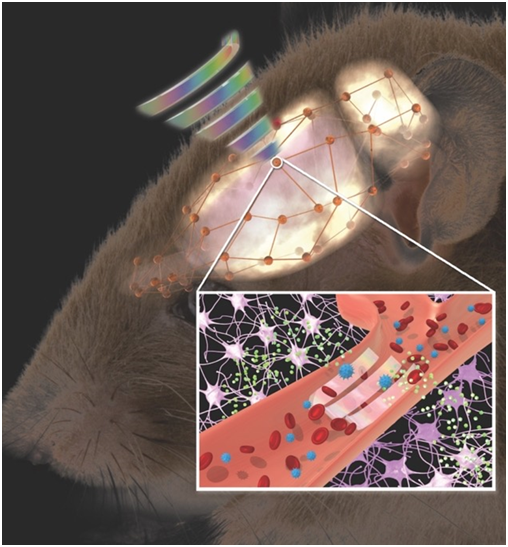
The blood brain barrier is an important component of brain. It is a complex system of cells namely endothelial, astroglia, pericytes, and perivascular mast cells. It is tightly bound and prevents passage of any cells circulating them. They are closely linked and are found in the vascular layer of the brain. The capillary junctions have tasks to perform. Task mainly to uphold the tightness in order to prevent the passage of any molecules or ions and movement of proteins between membranes of the blood brain barrier[25-28]. Before we go further, understanding of blood brain barrier is shown in the figure below[27].
Figure 9: Blood Brain Barrier.
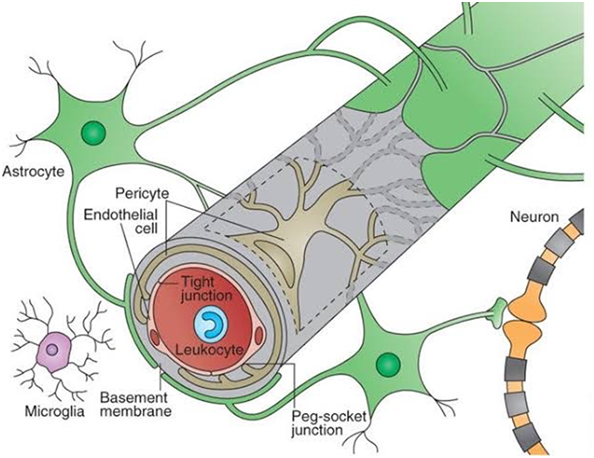
The tight junctions are mainly the base membrane containing adhesion molecules along with some proteins. Adhesion is important to remove the lymphocytes and neutrophils and dendritic cells to brain from vascular junction. They are performed during surveillance response[27]. The interconnections of this BBB are highly compact that possible exchange is viable only through cellular body. Brain needs nutrients to enhance its capabilities[28].Question arises in the entry of these nutrients to the brain. Nutrients such as glucose, amino acids, and ketones use specific transporters to reach brain[29]. BBB prevents uptake of any drugs, hence this Nano capsules were used. The size of these capsules is tiny in size and uses plasma coated surfactant surfaces to enter and target brain cells[31]. BBB has unique presence of glycoprotein pump allowing certain capillary cerebral drugs to enter and cure brain injury especially tumor or cancer cells. Nanoparticles always play a role in curing these cells[27]. Below is the figure showing the presence of nanoparticles entered through tight junction[30].
Figure 10: Showing the presence of nanoparticles entered through tight junction.
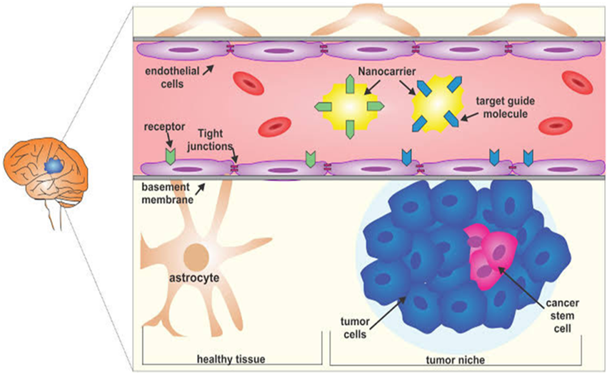
Alternate routes have been explored for drugs to enter the brain [32]. But older methods like modification of drugs, osmotic opening, and chemical composition have all been tried taking advantage of physiological carrier-based transport. Since the surface is limited, the quality and quantity of drugs are reduced [31-34].
Nanocapsule Implant for Mind Control
After thorough understanding of blood brain barrier, our focus lies in the drug design for mind control [35]. Since neurons have electrochemical nature in them, electrical impulsion and magnetic impulsions have a dedicated space in induction of drug. The electric and magnetic impulsion in brain is termed as neuromodulation, also called as deep brain stimulation(DBS)[37]. Neuromodulation is a method for implant of nanoparticles in the size range of 22 nm. They are coated with polymer to increase the compatibility while dispersing through blood brain barrier. Many experiments have been conducted in mice, and these implants have attained the targeted sites for mind modulation. Some other study also added that nanoparticle can stay for a month long in brain and provides ling lasting success in neuromodulation[37-45].They also prove to be a game changer economically. Below figure shows you nanoparticle in blood of brain[34].
Figure 11: Nanoparticle in blood of brain.
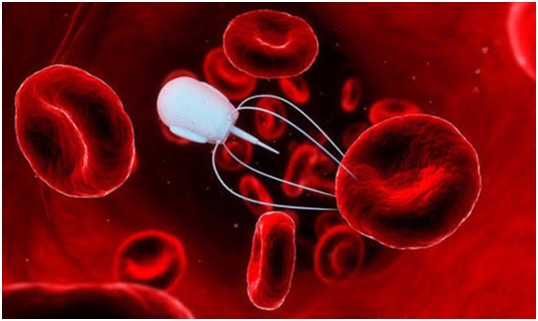
Brain trauma often can show symptoms of psychological effects and also can display holes in the grey matter. They affect the central nervous system and also are capable of inducing tissue repair in the brain[35]. Ordinary drug treatments have proved ineffective to treat these problems[34]. Some studies have shown nanocapsules have been vital in curing these injuries and also help in designing of the drug for future treatment. They also help in creating a cushion layer for brain treatment[40].
Brain Augmentation
There have been discoveries for development of tissue in grey matter[41]. Generally, tissues deform when conditions are suitable to grow. If glial cells are not formed properly, they could potentially degrade the nerve cells leading to stoke. Hence scientists opt for the usage of nanoparticles. They have precision drug targets and also help in curing brain damage[42]. Below is the graph representing nanoparticles behavior in the brain. T1 representing time[43].
Graph 1: Representing nanoparticles behavior in the brain.
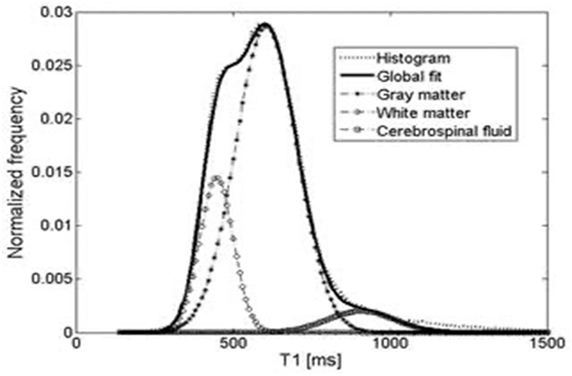
Understanding the pattern of nanoparticle in the brain, tissues culture accordingly to load the Nano gel in injection and injected into the brain cells [44]. These Nano gel target the specific part of the brain converting the under developing brain regions into mature cells via stem cell regeneration. Culturing the tissue outside the body is to help grow neurons accordingly to the environment of the brain tissue [45]. This method generally tends to adapt to the brain cells giving it a total control of nervous region. Brain cells then surround the gel which firm wire like structures. These wire-like structures are called nanowires [49]. These nanowires can help in the sending electrical signals in order for development of neurons and muscle cells. They also help in monitoring ph levels in the cells [46]. This model of development enhances our knowledge to augment the brain of an individual. They also help in artificial intelligence by melding organics and understanding neurons and its neural networks[37]. The nanowires unravel the complete working of mammalian brain. It is relatively safe method as they have been used before to treat Parkinson’s disease[47]. Below figure shows nanoparticles in brain function [50].
Figure 12: Nanoparticles in brain function.
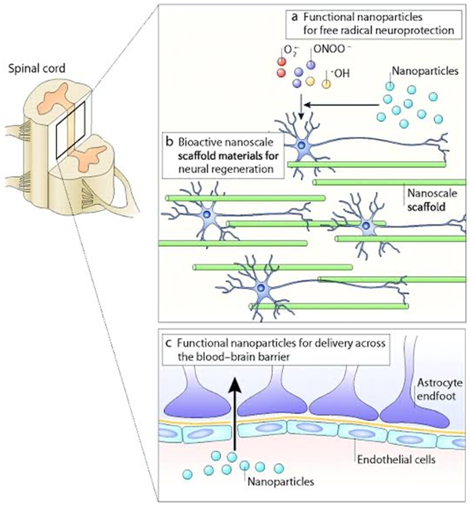
There has been a study that the device can measure dopamine part in the brain called caudate nucleus, and subthalamic mucleus in another part of brain. This sequence helps us understand DBS. They also help in monitoring neurochemicals that senses the pain [48] there is also another team working on healthy and disorder part of the brain using chemical senses.The understanding of brain cells or rather mind is inly achieved through DBS, nanogel sends the pulses through motor areas of an individual brain giving signals of thought. Some other study suggested making two nanowires meeting subthalamic region through the cortex region region for better understanding of mind [47]. It is increasingly important to use DBS method to understand brain functions and also treat brain diseases. Many neurological conditions such as depression, obsessive compulsive disorder, Tourette syndrome and other disease can be understood and cured [51]. This new found knowledge can help in interpretation of neuron signals to build even advanced implants for brain[52].Below graph shows several publications on brain study[49].
Graph 2: Shows several publications on brain study.
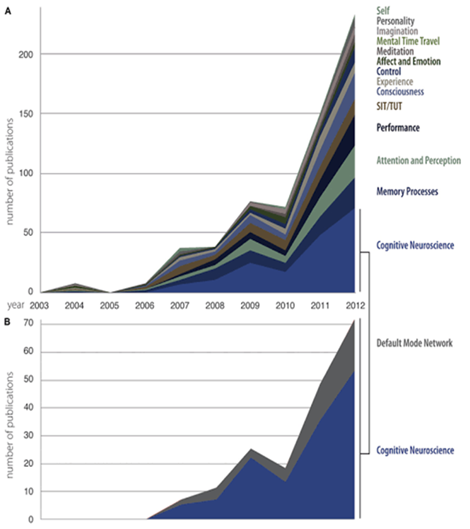
Another pie chart showing several areas of brain functions through DBS[29].
Pie chart 1: Showing several areas of brain functions through DBS.
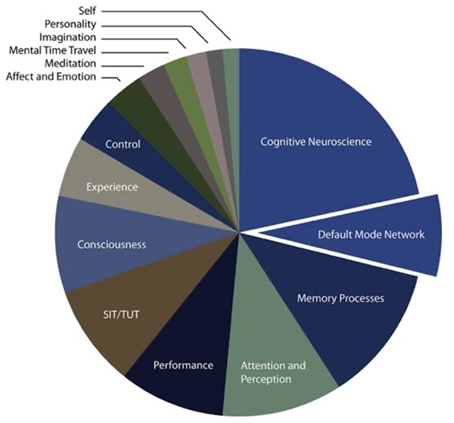
Brain augmentation issues with ethics
Ethics play a major role when augmenting mind. Different perspective to look into is health and safety, autonomy in privacy matters and future to the augmentation[51]. Health risks possess problem only when there is a lack of knowledge of an individual and nanoparticles accumulation time when it is longer[49-51]. Normally health does not pose risk when augmenting the mind. But concerns always arise with nanoparticles injected or implanted, and also drugs side effects. But these concerns have already been addressed while designing the drugs[51]. Only regulatory measure should be taken care is use of nanomaterials and their size limitations. Accumulation of these nanomaterials in brain is another aspect. By looking into these steps, health of an individual is addressed[50]. Autonomy and privacy issues adhere to the individual’s knowledge to track thoughts, experience and overall brain activity of self. The right to privacy is to get access to all information in their mobile device. Thus, the ethical issues can be addressed for augmentation[51].
Conclusion
The future of nanotechnology is to foresee new developments in treatments of brain diseases. The complete elimination of brain diseases is the goal of augmenting brain. Brain capacity and potential can be enhanced. The adverse side effects of present drugs can be kept under check. The exponential knowledge with nanoparticles can show interests in further study of brain cells. Brain augmentation shows innovative and promising approach to help brain reach its full potential and also show promising results in developing new nanoparticles and nanocapsules. It also helps in clinical improvements of brain and its diseases. Finally these applications concentrate on giving concrete solutions of applications of nerve cells to read and control the mind. It paves the way for new investments in brain augmentation.
References
1. Nygard E. Does one need to understand why health is valuable in order to find enhancement permissible? Sound Decisions: An Undergraduate Bioethics Journal. 2018;4(1):2.
2. Feynman RP. “There’s Plenty of Room at the Bottomâ€. Lecture. California, Pasadena.2017.
3. Khan I, Saeed K, Khan I. Nanoparticles: Properties, applications and toxicities. Arabian Journal of Chemistry. 2019;12(7):908-31.
4. Hu Y, Ehrich M, Fuhrman K, Zhang C. In vitro performance of lipid-PLGA hybrid nanoparticles as an antigen delivery system: lipid composition matters. Nanoscale research letters. 2014;9(1):434.
5. Draganski B, Gaser C, Busch V, Schuierer G, Bogdahn U, May A. Changes in grey matter induced by training. Nature. 2004;427(6972):311-2.
6. Kühn S, Gleich T, Lorenz RC, Lindenberger U, Gallinat J. Playing Super Mario induces structural brain plasticity: gray matter changes resulting from training with a commercial video game. Molecular psychiatry. 2014;19(2):265-71.
7. Gómez-Pinilla F. Brain foods: the effects of nutrients on brain function. Nat Rev Neurosci. 2008;9(7):568-78.
8. Cheng Y, Yin L, Lin S, Wiesner M, Bernhardt E, Liu J. Toxicity reduction of polymer-stabilized silver nanoparticles by sunlight. J Phys Chem C. 201;115(11):4425-32.
9. Lieber CM, Tian B, Liu J, inventors; Harvard College, assignee. Methods and systems for scaffolds comprising nanoelectronic components.2017.
10. Wang Y, Zheng Y, Xu X, Dubuisson E, Bao Q, Lu J. ACS Nano. 2011;9927-33.
11. Lind G, Linsmeier CE, Thelin J, Schouenborg J. Gelatine-embedded electrodes—a novel biocompatible vehicle allowing implantation of highly flexible microelectrodes. J Neural Eng. 2010;7(4):046005.
12. Benabid AL, Pollak P, Louveau A, Henry S, De Rougemont J. Combined (thalamotomy and stimulation) stereotactic surgery of the VIM thalamic nucleus for bilateral Parkinson disease. Stereotactic and functional neurosurgery. 1987;50(1-6):344-6.
13. Weinberger M, Mahant N, Hutchison WD, Lozano AM, Moro E, Hodaie M, et al. Beta oscillatory activity in the subthalamic nucleus and its relation to dopaminergic response in Parkinson's disease. J Neurophysiol. 2006;96(6):3248-56.
14. Van Vugt MK, Hitchcock P, Shahar B, Britton W. The effects of mindfulness-based cognitive therapy on affective memory recall dynamics in depression: a mechanistic model of rumination. Front Hum Neurosci. 2012;6:257.
15. Levy R, Ashby P, Hutchison WD, Lang AE, Lozano AM, Dostrovsky JO. Dependence of subthalamic nucleus oscillations on movement and dopamine in Parkinson’s disease. Brain. 2002;125(6):1196-209.
16. Mayberg HS, Lozano AM, Voon V, McNeely HE, Seminowicz D, Hamani C, et al. Deep brain stimulation for treatment-resistant depression. Neuron. 2005;45(5):651-60.
17. Osuch EA, Ketter TA, Kimbrell TA, George MS, Benson BE, Herscovitch MW, et al. Regional cerebral metabolism associated with anxiety symptoms in affective disorder patients. Biol Psychiatry. 2000;48(10):1020-3.
18. Little S, Pogosyan A, Neal S, Zavala B, Zrinzo L, Hariz M, et al. Adaptive deep brain stimulation in advanced Parkinson disease. Ann Neurol. 2013;74(3):449-57.
19. Gomezâ€Pinilla F, Hillman C. The influence of exercise on cognitive abilities. Compr Physiol. 2013;3(1):403-28.
20. Smith ME, Farah MJ. Are prescription stimulants “smart pills� The epidemiology and cognitive neuroscience of prescription stimulant use by normal healthy individuals. Psychol Bull. 2011;137(5):717.
21. Urban KR, Gao WJ. Performance enhancement at the cost of potential brain plasticity: neural ramifications of nootropic drugs in the healthy developing brain. Front Syst Neurosci. 2014;8:38.
22. De Jong WH, Borm PJ. Drug delivery and nanoparticles: applications and hazards. Int J Nanomedicine. 2008;3(2):133.
23. Airan RD, Meyer RA, Ellens NP, Rhodes KR, Farahani K, Pomper MG, et al. Noninvasive targeted transcranial neuromodulation via focused ultrasound gated drug release from nanoemulsions. Nano letters. 2017;17(2):652-9.
24. Wohlfart S, Gelperina S, Kreuter J. Transport of drugs across the blood–brain barrier by nanoparticles. J Control Release. 2012;161(2):264-73.
25. Delaloye S, Holtzheimer PE. Deep brain stimulation in the treatment of depression. Dialogues Clin Neurosci.2014;16(1):83.
26. Chen R, Romero G, Christiansen MG, Mohr A, Anikeeva P. Wireless magnetothermal deep brain stimulation. Science. 2015;347(6229):1477-80.
27. Caras A, DeJesus J. Ethical analysis of brain augmentation through nanotechnology. Sound Decisions: An Undergraduate Bioethics Journal. 2018;4(1):4.
28. Sauerbeck A, Gao J, Readnower R, Liu M, Pauly JR, Bing G, et al. Pioglitazone attenuates mitochondrial dysfunction, cognitive impairment, cortical tissue loss, and inflammation following traumatic brain injury. Exp Neurol. 2011;227(1):128-35.
29. Wei Z, Zhao J, Chen YM, Zhang P, Zhang Q. Self-healing polysaccharide-based hydrogels as injectable carriers for neural stem cells.Sci Rep. 2016;6:37841.
30. Tian B, Liu J, Dvir T, Jin L, Tsui JH, Qing Q, et al. Macroporous nanowire nanoelectronic scaffolds for synthetic tissues. Nat Mater. 2012;11(11):986-94.
31. Berger TW, Hampson RE, Song D, Goonawardena A, Marmarelis VZ, Deadwyler SA. A cortical neural prosthesis for restoring and enhancing memory. J Neural Eng. 2011;8(4):046017.
32. Liu J, Fu TM, Cheng Z, Hong G, Zhou T, Jin L, et al. (2015) Syringe Injectable Electronics. Springer Theses Biomimetics Through Nanoelectronics. 2015:65-93.
33. Zhou T, Hong G, Fu TM, Yang X, Schuhmann TG, Viveros RD, et al. Syringe-injectable mesh electronics integrate seamlessly with minimal chronic immune response in the brain. Proc Natl Acad Sci U S A. 2017;114(23):5894-9.
34. Rosenfeld JP, Nasman VT, Whalen R, Cantwell B, Mazzeri L. Late vertex positivity in event-related potentials as a guilty knowledge indicator: A new method of lie detection. Int J Neurosci. 1987;34(1-2):125-9.
35. Shibata K. A new neuroscientific approach using decoded neurofeedback (DecNef). Rinsho shinkeigaku. Rinsho Shinkeigaku. 2012;52(11):1185-7.
36. Deadwyler SA, Hampson RE, Sweat A, Song D, Chan RH, Opris I, et al.Donor/recipient enhancement of memory in rat hippocampus. Front Syst Neurosci. 2013;7:120.
37. Jotterand F. Beyond therapy and enhancement: The alteration of human nature. Nanoethics. 2008;2(1):15-23.
38. Lin P, Allhoff F. Untangling the debate: The ethics of human enhancement. NanoEthics. 2008;2(3):251.
39. Milleson V. Nanotechnology, the brain, and the Future: Ethical considerations. InNanotechnology, the Brain, and the Future 2013:79-96.
40. Caras A, DeJesus J. Ethical analysis of brain augmentation through nanotechnology. Sound Decisions: An Undergraduate Bioethics Journal. 2018;4(1):4.
41. OMathúna, D. Nanoethics: big ethical issues with small technology. Continuum. 2010.
42. Schermer M. The mind and the machine. On the conceptual and moral implications of brain-machine interaction. Nanoethics. 2009;3(3):217.
43. Bostrom N, Sandberg A. Cognitive enhancement: methods, ethics, regulatory challenges. Sci Eng Ethics. 2009;15(3):311-41.
44. Greely H, Sahakian B, Harris J, Kessler RC, Gazzaniga M, Campbell P, et al. Towards responsible use of cognitive-enhancing drugs by the healthy. Nat. 2008;456(7223):702-5.
45. Nagel SK. Too much of a good thing? Enhancement and the burden of self-determination. Neuroethics. 2010;3(2):109-19.
46. Gilbert F. A threat to autonomy? The intrusion of predictive brain implants. AJOB neuroscience. 2015;6(4):4-11.
47. https://cs.stanford.edu/people/eroberts/cs181/projects/2010-11/DownloadingConsciousness/tandr.html
48. McBride WG. Thalidomide embryopathy. Teratology. 1977;16(1):79-82.
49. Colborn T, Vom Saal FS, Soto AM. Developmental effects of endocrine-disrupting chemicals in wildlife and humans. Environmental health perspectives. 1993;101(5):378-84.
50. The Justice (Or Lack Thereof) of Brain Augmentation through Nanotechnology MKM Nevins - Sound Decisions: An Undergraduate. 2018.
51. Ethical Aspects of Interventional Neuroscience. Nanoneuronal InterfacesKH Keskinbora, MA Jameel -eLS. 2001
